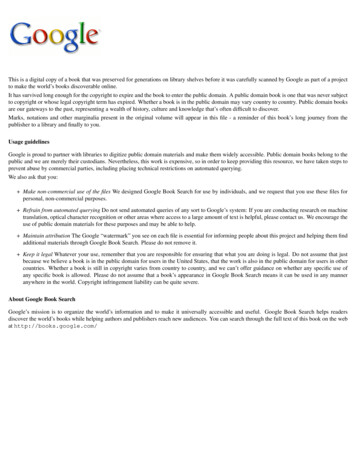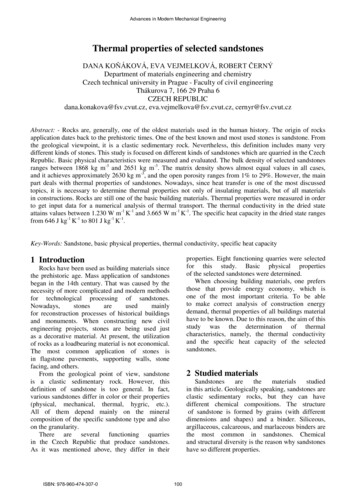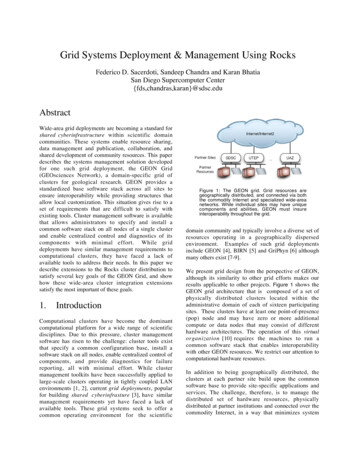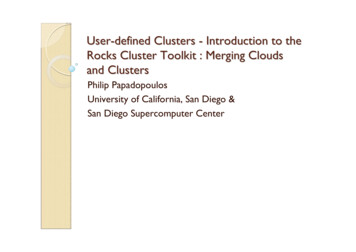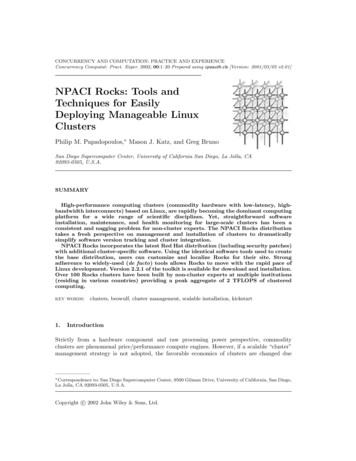
Transcription
UNITED STATES DEPARTMENT OF THE INTERIORGEOLOGICAL SURVEYTHERMAL PROPERTIES OF ROCKSbyEugene C. Robertson 1Open-File Report 88-441This report is preliminary and has not been reviewed for conformity with U.S. GeologicalSurvey editorial standards and stratigraphic nomenclature.1 Reston, Virginia1988
-------3Symbols4Thermal conductivity5Introduction5Solidity5Thermal impedance5Calculation of composite models6Porefluid8Quartz, olivine, pyroxene, amphibole, and clay content8Rock conductivity at 300 K10Introduction10Mafic igneous rocks, air in pores11Mafic igneous rocks, water in pores13Felsic igneous rocks, air or water in pores14Limestone, air or water in pores16Dolostone, air or water in pores18Sandstone, air in pores20Sandstone, water in pores22Shale, water in pores24Shale, air in pores26Soils, air in pores 28Anhydrite, gypsum, air in pores30Selected rocks31Conductivity anisotropy of metamorphic rocks32Rock conductivity change with temperature34Introduction34Basalt and other mafic rocks34Felsic igneous rocks35Carbonate rocks36Quartz-bearing rocks37Ultramafic rocks39Rock glasses40Mineral conductivity change with temperature41Introduction- 41Quartz- 41Feldspar42Plagioclase43Mafic silicate minerals44Olivine46Calcite and aragonite47Halite48Mineral conduction mechanisms49Phonon and imperfection conductivity49Radiative conductivity49Analysis of mechanisms . - 50Miscellaneous thermalconductivities58Pressure effect on thermal conductivity59Thermal conductivity under vacuum62Thermal expansion and density of minerals- 6511
Specific heat of rockIntroductionCalculation of specificheat-Diffusivity and thermal inertiaCalculation ofparametersHeat transfer coefficientsRadioactive heat generation in rocksAppendix I. Modes of heat transmissionReferences--- -- 7.28.29.30.31.32.33.34.35.36.37.Thermal conductivity of mafic rocks, air in poresThermal conductivity of mafic rocks, water in poresThermal conductivity of felsic rocks, air in poresThermal conductivity of felsic rocks, water in poresThermal conductivity of limestone, air in poresThermal conducivity of limestone, water in poresThermal conductivity of dolomite, air in poresThermal conductivity of dolomite, water in poresThermal conductivity of sandstone, air in poresThermal conductivity of sandstone, water in the poresThermal conductivity of shale, water in poresThermal conductivity of shale, air in poresThermal conductivity of soils, air in poresThermal conductivity of anhydrite and gypsum, air in poresTemperature effect on thermal conductivity of mafic rocksTemperature effect on thermal conductivity of felsic igneous rocksTemperature effect on thermal conductivity carbonate rocksTemperature effect on thermal conductivity sandstones, quartzites, and shalesTemperature effect on thermal conductivity of ultramafic rocksTemperature effect on thermal conductivity of rock glassesTemperature effect on thermal conductivity of quartzTemperature effect on thermal conductivity of plagioclaseTemperature effect on thermal conductivity of albite-anorthite solid solutionsTemperature effect on thermal conductivity of mafic silicate mineralsTemperature effect on thermal conductivity of forsterite-fayalite solid solutionsTemperature effects on thermal conductivity of calcite and aragoniteThermal conductivity of single crystal halite showing temperature-pressure effectsSemilogarithmic plot of thermal conductivity against reciprocal temperature forfelsic mineralsSemilogarithmic plot of thermal conductivity against reciprocal temperature formafic mineralsSpecific heats of silica minerals, halite, and cordierite, per unit weightSpecific heats of feldspars per unitweightSpecific heats of certain pyroxenes, amphiboles, and micas, per unit weightSpecific heats of carbonates per unitweightSpecific heats of olivines and iron oxides per unit weightSpecific heats of aluminum silicates and apatite per unit weightSpecific heats of water and steam per unit weightSpecific heats of silica minerals, halite, and cordierite, per unit 142434546474851527273747576777879
38.39.40.41.42.43.44.Specific heats of feldspars per unitvolumeSpecific heats of pyroxenes, amphiboles, and micas per unit volumeSpecific heats of carbonates per unitvolumeSpecific heats of oxides and olivine per unit volumeSpecific heats of aluminum silicates and apatites per unit volumeComparison of calculated with observed specific heats of six rocksComparison of calculated with observed diffusivities of four 2.13.14.15.16.17.Thermal conductivity at 300 K and 5 MPa of selected igneous and metamorphic rocksAnisotropy of thermal conductivity at 300 K and 5 MPa of metamorphic rocksActivation energies and intercept conductivity constants of Boltzmann equation forconduction mechanisms in single crystal mineralsRounded values of activation energies of mineral conduction mechanismsRounded values of intercept conductivity constant of mineralsMiscellaneous thermal conductivities and their temperature effectsEffect of pressure on thermal conductivity of certain minerals and rocksThermal conduction under vacuumThermal expansion and density of mineralsThermal expansion of rocks for the temperature interval 20 C to 100 CBulk density of common rocksSpecific heats of common rocksDiffusivity and thermal inertia of commonrocksHeat transfer coefficientsThermal conductivities of air and waterCharacteristic thickness of stationary fluid layer for estimating heat transfer coeffientsRadioactive heat generation in rocksIV3132535657586063666970879092949597
THERMAL PROPERTIES OF ROCKSBy Eugene C. RobertsonABSTRACTAll the important thermal properties of rocks can be estimated from the graphs and tables in this report.Most of the useful published data are summarized herein to provide fairly accurate evaluations of thermal coefficientsand parameters of rocks for many engineering and scientific purposes.Graphs of the published data on common rocks and minerals were prepared to show the relationships ofthermal conductivity with decimal solidity (one minus decimal porosity), water or air pore content, content of certainhighly conducting minerals, and temperature. Tables are given of pressure effect on thermal conductivity of mineralsand rocks, anisotropy of conductivity, thermal expansion, heat transfer, density, heat generation in rocks, andactivation energies of conduction mechanisms in single crystals of minerals. A series of graphs show the specificheats of rock-forming minerals as a function of temperature; with these graphs the specific heat of a rock can becalculated from its mode as accurately as it can be measured. Calculations of conductivity, diffusivity, and thermalinertia of a rock from its mode are described. Discussions of radiative thermal conductivity, radioactive heat generation, and heat transfer in rocks are provided.INTRODUCTIONEvaluation of the conduction and absorption of heat in the upper crust of the Earth for practical and forresearch purposes requires knowledge of the thermal properties of the rocks found there. Heat transmission in theearth occurs principally by conduction and secondarily by convection and radiation; all are summarized in theAppendix. By radiation, heat is transmitted optically through a transparent medium or space. Convective heat istransferred between a convecting fluid and a solid or other fluid. Conduction within a solid, liquid , or gas is theprincipal mode of heat transfer in the earth and is the principal thermal property considered herein. Summarydiscussions are provided of radiative conductivity and of convective heat transfer coefficients; a transfer coefficient isnot a property of a substance but involves mass transport of heat by a fluid and conduction of heat in a solid and thefluid through their contact surface.This compilation attempts primarily to summarize the best published observational data on thermal conductivity of rocks and minerals as affected by composition, porosity, water content, pressure, and temperature. Data aregiven for the common igneous and metamorphic rocks and for sedimentary sandstone, shale, and limestone andsummary data are given for other less-common rocks. Specific heats for rocks can be obtained from data onrock-forming minerals. It is anticipated that values of these thermal properties of rocks and minerals will be useful forradioactive waste management, heat flow studies, and geothermal resource appraisals, and other thermal problemsin the earth.The approach taken is to provide graphs and simple formulas from which a thermal property of a rock can beclosely estimated from a minimum knowledge of its compositional and textural characteristics. They are especiallyuseful for friable, porous rocks and dense but inaccessible rocks. Tables are provided of data inappropriate forgraphical presentation. In using these laboratory data, the rocks are assumed to be isotropic and homogeneous,although of course, rocks in place have large-scale inhomogeneities of bedding, foliation, fracturing, and othervariations in composition and structure. However, one can usually assume large scale homogeneity due to randomness of mineral distribution and grain orientation.An alternative approach is to take data from graphs and tables of measurements on rock-forming minerals tocalculate from its mineral composition (mode) a combined value for a rock of its thermal conductivity, as described inthe next section. Unfortunately, modes are seldom determined on rocks, so the above empirical approach usinggraphs is more feasible.
The best published compilation of thermal conductivities of rocks is in the tables of Clark (1966, section 21).The theory of conduction of heat is described for geologic purposes by Ingersoll and others (1954), and the classictreatise is by Carslaw and Jaeger (1959). The basis for the graphs of conductivity shown hereafter is the finding forvesicular basalt by Robertson and Peck (1974) that thermal conductivity varies as a function of the complement ofporosity squared, air or water pore saturation, and content of highly-conducting phenocrysts.Thermal conductivity is given emphasis in this compilation because it is needed in all calculations involvingheat conduction in the earth. (An earlier compilation is in Robertson, 1979.) In figures 1-13 the effects of porosity,water content, and quartz, olivine, pyroxene, and clay content on conductivities of most felsic and mafic rocks areshown. Data for other less-common igneous rocks are listed in table 1. Anisotropy data for metamorphic rocks aregiven in table 2. The effect of temperature on conductivity is shown for the common rocks in figures 14-19 and forrock-forming minerals in figures 21-26. Conduction mechanisms and activation energies as a function of temperaturein mineral crystals and aggregates are considered in the text associated with figures 28 and 29 and tables 3-5;however, the data on conduction mechanisms in rocks are still inaccurate. The available data on the effect ofpressure and vacuum on conductivity of rocks and minerals are given in tables 7 and 8. The conductivities of most ofthe common minerals, both single crystal and polycrystalline, are given in an accompanying open-file report of Dimentand others (1988), as well as in Horai (1971) and in Clark (1966, Sec. 21).Thermal expansions (from Skinner, 1966), and densities (from Robie and others, 1967) are listed for singlecrystals of the common minerals in table 9. Expansions and densities of common rocks are given in tables 10 and11.The specific heats at constant pressure of many rock-forming minerals as a function of temperature areplotted in joules per kelvin per unit weight in figures 30-36 and in joules per kelvin per unit volume in figures 37-42.These plots are from tables of Robie and Waldbaum (1968). The specific heat of a rock is easily calculated fromvalues of the minerals in its mode (fig. 43 and discussion); this approach is unique, as the usual calculation is fromoxides from chemical analyses. Values of specific heat for a rock are useful for many other purposes than heatconduction, of course.Measurements have been reported on the thermal diffusivities of rocks and minerals, but they are sparse,and so are not assembled separately here. Reasonably accurate values for the diffusivities and for thermal inertia,the parameter of periodic heat conduction in rocks, can be calculated from conductivities, specific heats, anddensities of the mineral components, and data plotted or tabulated in this report can be used.Convective heat transfer coefficients applicable to rocks are described and listed in table 14; characteristicthicknesses and conductivites of air, water, and steam are provided in tables 15 and 16 to estimate transfer coefficients for earth environments, although only roughly. Radioactive heat generation values in rocks are discussed andlisted in table 17.The author gratefully acknowledges the encouragement and help from William H. Diment, and from RichardA. Robie and Bruce S. Hemingway, who provided the specific heat data used in figures 30-42. The author is gratefulalso to Rudolph Raspet and R. W. Werre for apparatus construction and maintenance. The author acknowledges thehelpful collaboration of Dallas L Peck who established the effect of olivine phenocrysts on increasing conductivity.Helpful comments have been given by David D. Blackwell and John Sass, and other colleagues and are muchappreciated.
UnitsThe SI units are shown on all drawings, but cgs units and English units are still common in thermal-propertyliterature. The following conversion relations may be useful:Thermal conductivity:W/m«K- 2.390 x10'3 cal/cm sec C 0.5797 Btu/ft hr FThermal diffusivity:2,1 m /sec 10.4 cm/sec 10.764 ft2/secHeat flow:
thermal conductivity with decimal solidity (one minus decimal porosity), water or air pore content, content of certain highly conducting minerals, and temperature. Tables are given of pressure effect on thermal conductivity of mineralsCited by: 459Page Count: 110File Size: 1MBAuthor: Eugene C. Robertson

